

AD Classics: Lafayette Park / Mies van der Rohe. Situated at the eastern edge of Downtown Detroit, Lafayette Park constitutes the world’s largest collection of buildings designed by Mies van der Rohe.

The 78-acre complex was completed in 1959, just after Crown Hall and the Seagram Building. It is not as well known as many Mies projects of that decade, however, many critics argue the project deserves greater recognition. One of the first examples of urban renewal, it is a testament to the development’s design that it remains a vibrant neighborhood more than fifty years after its construction. Mies van der Rohe - 1:1 Modell Golfclubhaus . Krefeld. Mies van der Rohe. Mies in Krefeld - Architectural Visualization. Mies van der Rohe - 1:1 Modell Golfclubhaus . Krefeld. Mies van der Rohe casa farnsworth . ilinois. Fotos: Natasha Pirondi . + wikiarquitectura La casa es el resultado de un encargo de la Doctora Edith Farnsworth, en 1945, para construir un lugar de retiro de fin de semana.
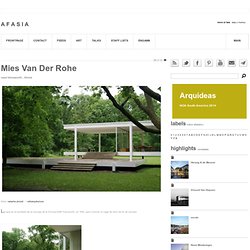
Las obras comenzaron en 1950, finalizándose en su mayor parte en 1951. La vivienda se sitúa en una parcela de 24 hectáreas a orillas del río Fox, a unos 90 km al sur de Chicago. La construcción se eleva del terreno para formar un patio rectangular de 16,7x6,7 m (111 m2), y un nuevo rectángulo se eleva hasta los 1,5 m formando propiamente la vivienda, de unas dimensiones de 23,5x8,8 m2 (206 m2),[5] de los que aproximadamente 140m2 están cerrados por una envolvente de vidrio. La cocina y los dos baños se agrupan en una pastilla central con acabados en madera, que aloja las instalaciones y articula la separación entre las distintas zonas de la vivienda, dejando libre circulación en todo el perímetro. Mies van der Rohe . tugendhat villa renovation . brno. Tugendhat Villa Renovation .
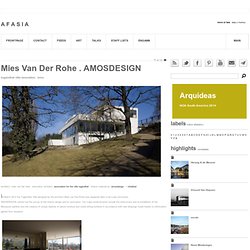
Brno Architect: Mies van der Rohe . Renovation architect: Association for the Villa Tugendhat . Interior realized by: AMOSDESIGN . + inhabitat In March 2012 the Tugendhat Villa designed by the architect Mies van Der Rohe was reopened after a two-year renovation. Property owner and investor: Statutory city of Brno Renovation architect: Association for the Villa Tugendhat General contractor: Unistav Interior realized by: AMOSDESIGN Furniture and interior research for implementation: Miroslav Ambroz and AMOSDESIGN Supervision: THICOM.
75 Years of Mies van der Rohe and His Chicago School. Chicago Federal Center / Mies van der Rohe. The Chicago Federal Center, designed by Ludwig Mies van der Rohe and completed in 1974, actually consists of three buildings which are arranged around and define the Chicago Federal Plaza.
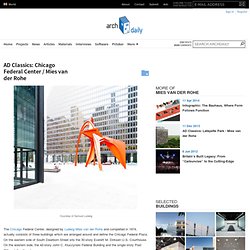
On the eastern side of South Dearborn Street sits the 30-story Everett M. Dirksen U.S. Courthouse. On the western side, the 42-story John C. Kluczynski Federal Building and the single story Post Office define the plaza. The complex as a whole was completed in 1974, five years after Mies’s death. The project has its roots in a 1950s plan by the U.S. Infographic: Celebrating Mies van der Rohe.
Conversion of Mies van der Rohe Gas Station / Les Architectes FABG. Architects: Les Architectes FABG – Éric Gauthier Location: 201 rue Berlioz, Verdun, Québec, Canada Client: Arrondissement de Verdun Design Team: Marc Paradis, Dominique Potvin, Jaime Lopez, Steve Montpetit Engineers: Aecom Builder: Norgéreq Cost: 1.4 M $ Completion: 2011 Photographs: Steve Montpetit Nun’s Island is part of the Hochelaga archipelago located immediately southwest of Montreal.
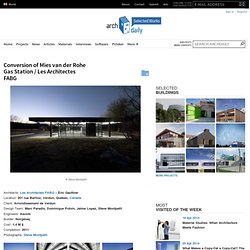
It’s urbanization followed the opening of the Champlain bridge in 1962 under an ambitious master plan carried out by Metropolitan Structures, a real estate giant who had built numerous projects in Chicago with the collaboration of Mies van der Rohe. The new community included three high rise apartment buildings by Mies office and it led, in 1966, to a commission from Standard Oil to design a prototypical gas station. The station consists of two distinct volumes, one for car servicing and the other for sales, with a central pump island covered by a low steel roof that unifies the composition.
Mies van der Rohe's Czech Masterpiece: Tugendhat House. Villa Tugendhat / Mies van der Rohe. The Villa Tugendhat was commissioned by the wealthy newlyweds Grete & Fritz Tugendhat, a Jewish couple with family money from textile manufacturing companies in Brno.
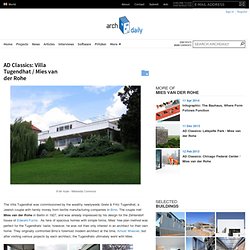
The couple met Mies van der Rohe in Berlin in 1927, and was already impressed by his design for the Zehlendorf house of Edward Fuchs. As fans of spacious homes with simple forms, Mies’ free plan method was perfect for the Tugendhats’ taste; however, he was not their only interest in an architect for their own home. Mies van der Rohe: 1951-52 McCormick House Documentary. The Museum of Fine Arts Houston / Mies Van der Rohe. After completing a master plan for the site in 1953, Ludwig Mies van der Rohe was commissioned by The Museum of Fine Arts Houston to do two additions to the Caroline Wiess Law Building.
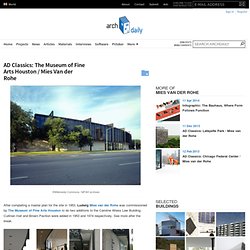
Cullinan Hall and Brown Pavilion were added in 1953 and 1974 respectively. See more after the break. The museum’s original building was designed in 1924 by William Ward Watkin in the Neoclassical style. Here, the South facade features tall Greek columns. In contrast, Van der Rohe’s addition on the North side of the museum stands as a renowned example of International style.
Utilizing 30 foot ceilings, and 6,800 square feet of open floor space, Cullinan Hall is the museum’s largest and most flexible space for events. Landhaus Lemke / Mies van der Rohe. The Landhaus Lemke private residence by Mies van der Rohe exudes the crisp, clean and formal aesthetics that are characteristic of his architectural proclivity.
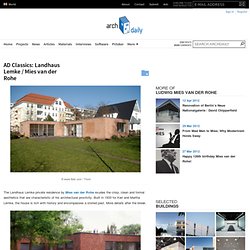
Built in 1933 for Karl and Martha Lemke, the house is rich with history and encompasses a storied past. More details after the break. IBM Building / Mies van der Rohe. Completed four years after architect Mies van der Rohe‘s passing, the IBM Building became one of the cities most prestigious addresses.

A pure symbol of the architecture of the time, the almost 700 foot tall rectangle sits on a raised plinth that helps it to maintain a uniform height given the unevenness of the site; State Street to the structure’s west inclines steeply. More on the IBM Building, also known as 330 North Wabash, after the break.
As architecture, the IBM Building, along with many others designed by Mies van der Rohe, becomes synonymous with corporate power. Black anodized aluminum and gray-tinted glass are used together to create a uniform skin that gives the appearance of a single imposing and impressive volume. It’s strength and clarity of form are distinguishable and appreciated along the Chicago skyline, a tribute to the lifelong study of structural expression, organizational scale, material simplicity, proportion, and constructive detail.
Barcelona Pavilion / Mies van der Rohe. As part of the1929 International Exposition in Barcelona Spain, the Barcelona Pavilion, designed by Mies van der Rohe, was the display of architecture’s modern movement to the world.
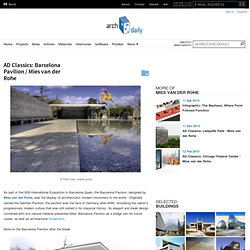
Originally named the German Pavilion, the pavilion was the face of Germany after WWI, emulating the nation’s progressively modern culture that was still rooted in its classical history. Its elegant and sleek design combined with rich natural material presented Mies’ Barcelona Pavilion as a bridge into his future career, as well as architectural modernism. More on the Barcelona Pavilion after the break. Mies van der Rohe Society.